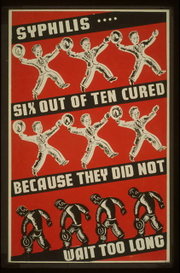Abstract
Syphilis is an unusual diagnosis in an ENT practice. We evaluated a 55-year-old man who had generalized plaques on his face, neck, and upper extremities. Analysis of skin biopsy and serology specimens revealed that the patient had secondary syphilis. He responded rapidly to treatment. The purpose of this article is to remind otolaryngologists of the signs and symptoms of syphilis so that it can be recognized and treated in a timely fashion.
Introduction
Syphilis can be either acquired (usually by sexual contact, but occasionally by blood transfusion) or congenital. (1) After the Treponema pallidum spirochetes make their initial penetration, they multiply rapidly. First they enter the lymph capillaries, where they are transported to the nearest lymph nodes. There they continue to multiply and are released into the bloodstream. Within days, the spirochetes invade every part of the body. The progression of the disease is marked in three stages: primary, secondary, and tertiary. (1,2) Syphilis is highly contagious and involves tissues throughout the body. (3)
The onset of the secondary stage can occur at any time from 1 week to 6 months after the initiation of the primary stage. The hallmark of this stage is a generalized skin rash. The classic skin lesions of secondary syphilis are scaly, reddish-brown papules or plaques. This stage can last for up to 6 weeks, and it can be accompanied by systemic symptoms such as fever, myalgia, and arthralgia. Another type of lesion--condyloma latum--can also appear, usually as warty patches on the genital organs. (4)
High-risk populations include those who have multiple sexual partners, unknown partners, or partners who engage in any high-risk sexual practice. Syphilis is more prevalent in larger metropolitan areas and among lower socioeconomic groups. The worldwide incidence of secondary syphilis is 3 per 10,000 population. (5)
Improved treatment and the subsequent decrease in syphilis morbidity have resulted in a de-emphasis of its clinical evaluation by the history and physical examination. This is unfortunate because recognition of the clinical signs and symptoms of early syphilis is often needed to prompt the physician to order a blood test. (6) In this article, we describe a case of secondary syphilis that we were able to recognize and treat quickly.
Case report
A 55-year-old man came to us with a 20-day history of generalized papules and plaques scattered over his face, neck, and upper extremities. His cervical lymph nodes were not palpable. He had no family history of similar lesions. Physical examination revealed that the plaques had slightly raised and scaly borders. No lesions were found in the oral cavity, but a few were seen on the scalp.
A punch biopsy specimen was obtained from one of the neck plaques under local anesthesia. Findings on H&E staining were compatible with a diagnosis of syphilis (figure). The sample was notable for a dense infiltrate that contained many plasma cells in the reticular dermis and for endothelial swelling and proliferation. The serologic tests for syphilis were positive; the VDRL test was positive at 1:512, and the hemagglutination test was positive at 1:20,480. A diagnosis of secondary syphilis was thus confirmed, and the patient was prescribed amoxicillin (1 g bid for 4 wk). His eruptions healed within I week.
Discussion
Because the signs of syphilis are variable, the clinical description of its progression covers only the likely course in most patients. Despite many textbook depictions, cutaneous syphilis is often inconspicuous, and its signs and symptoms can be easily overlooked or misinterpreted. The skin manifestations of secondary syphilis, called syphilids, occur in 80% of patients. (7) Early eruptions are characterized by the symmetric and fairly generalized appearance of superficial nondestructive maculopapular or papular lesions. These eruptions usually involve the face, upper extremities, neck, scalp, palms, and genital area.
The purpose of this article is to remind otolaryngologists of the signs and symptoms of syphilis so that it can be recognized and treated in a timely fashion. We are not advocating, of course, that we should automatically obtain syphilis serology or biopsy for every patient with similar lesions on the head and neck. The cost-effectiveness of routine tests must always be kept in mind. The best way to avoid missing the diagnosis is to be aware of its signs and symptoms, recognize them, and proceed to serologic testing.
References
(1.) Tham SN, Ng SK. Secondary syphilis with framboesiform lesions. Genitourin Med 1990;66:99-100.
(2.) Shimizu T, Shinogi J, Majima Y, Sakakura Y. Secondary syphilis of the tonsil. Arch Otorhinolaryngol 1989;246:117-20.
(3.) Kirwald H, Montag A. [Stage 3 syphilis of the mouth cavity]. Laryngorhinootologie 1999;78:254-8.
(4.) Mannara GM, Sacilotto C, Frattasio A, et al. Bilateral secondary syphilis of the tonsil. J Laryngol Otol 1999;113:1125-7.
(5.) Lambert WC, Bagley MP, Khan Y, Schwartz RA. Pustular acneiform secondary syphilis. Cutis 1986;37:69-70.
(6.) Harden D, Keeling JH. Papular and nodular lesions of the scalp, face, and neck. Secondary syphilis. Arch Dermatol 1997;133:1027,1030.
(7.) Chapel TA. The signs and symptoms of secondary syphilis. Sex Transm Dis 1980;7:161-4.
COPYRIGHT 2002 Medquest Communications, Inc.
COPYRIGHT 2002 Gale Group




